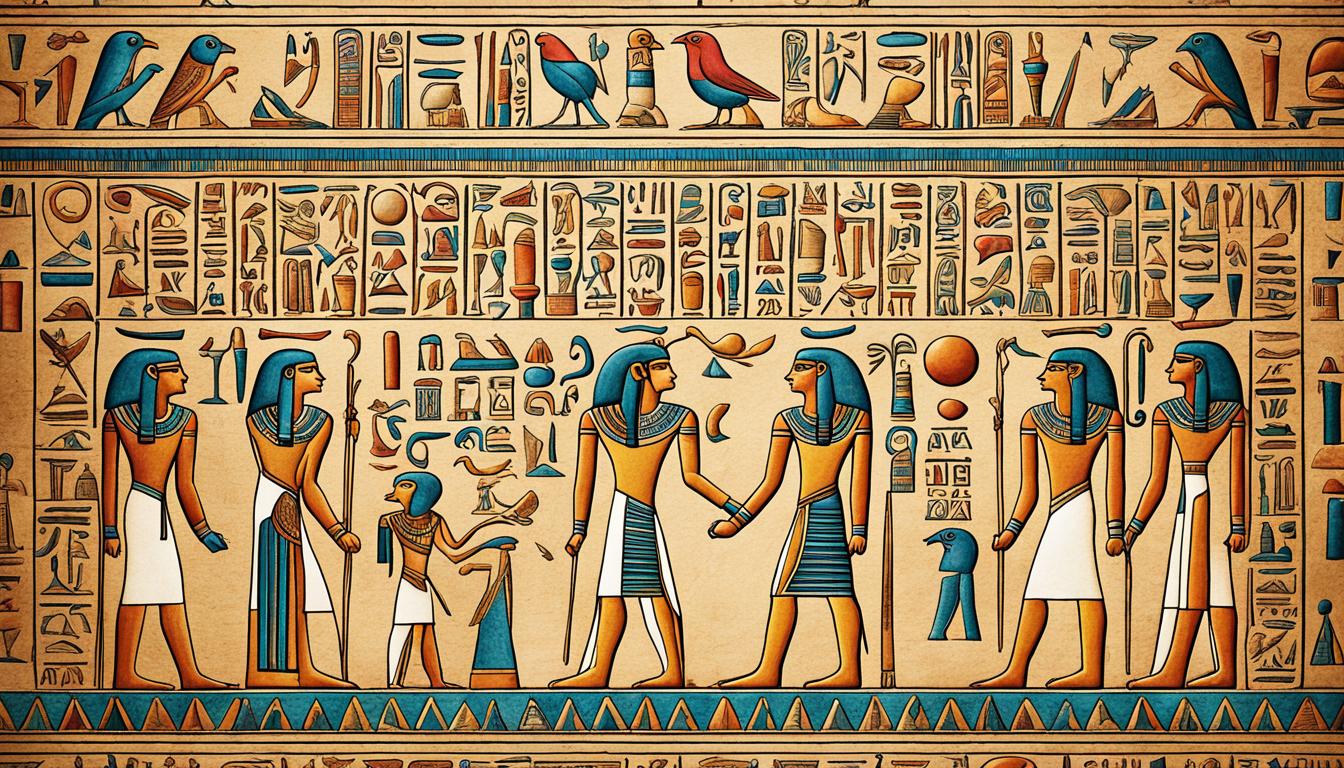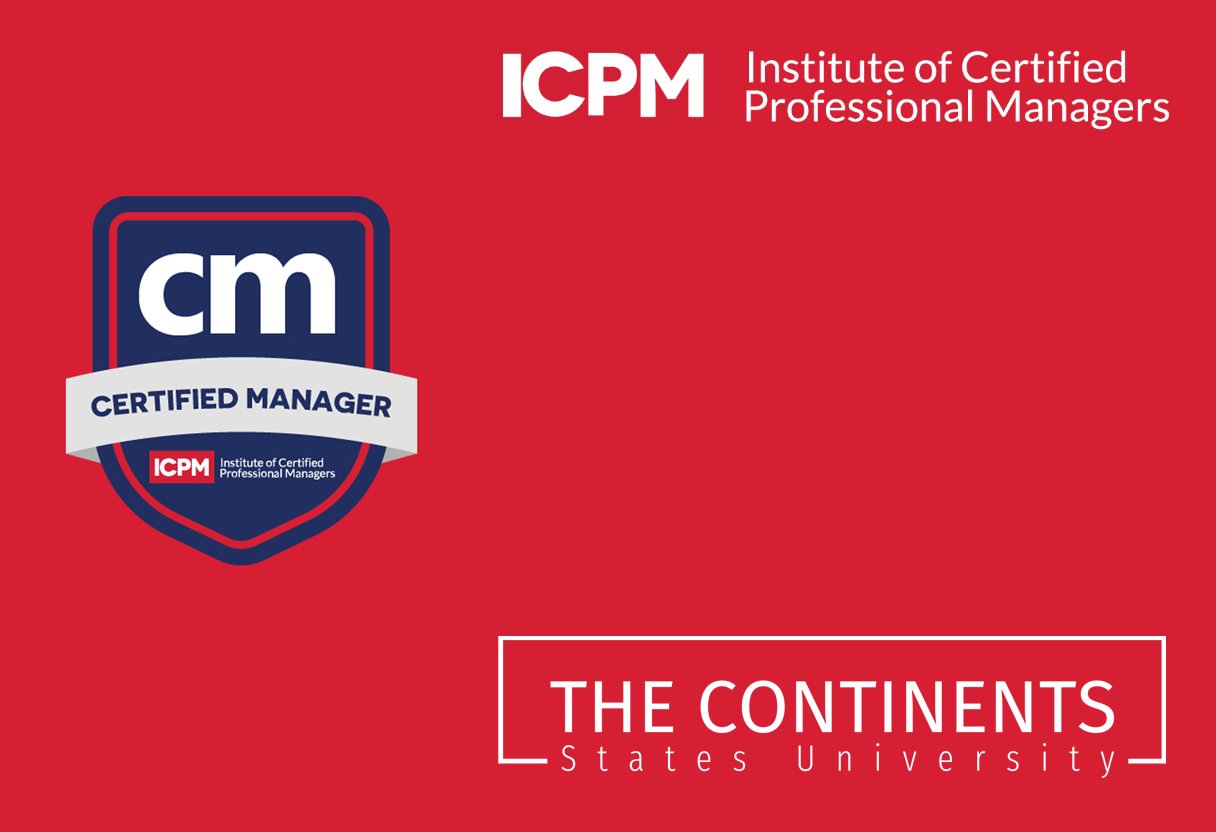Did you know that the ancient Egyptians developed one of the world’s earliest and most sophisticated writing systems, hieroglyphics, over 5,000 years ago? This captivating form of communication, carved into the walls of majestic temples and tombs, has captivated and intrigued scholars and enthusiasts alike for centuries. As the capital of Egypt, Cairo stands as the epicenter of this captivating exploration, where the wonders of Egyptology and the enigmatic hieroglyphic script come alive.
From the awe-inspiring Pyramids of Giza to the treasures of the Egyptian Museum, Cairo is a veritable playground for those fascinated by the ancient Egyptian civilization. The city’s vibrant streets teem with the echoes of a rich cultural heritage, where the legacy of the Pharaohs and the enigmatic Rosetta Stone come together to unlock the secrets of the past.
Delve into the captivating world of Egyptian hieroglyphics, unravel the mysteries of the River Nile, and immerse yourself in the grandeur of the Tutankhamun legacy. Cairo, a city where history and modernity coexist, invites you to embark on a transformative journey through the timeless wonders of Egyptology.
Key Takeaways
- Discover the ancient Egyptian writing system of hieroglyphics, developed over 5,000 years ago.
- Explore the captivating world of Egyptology in Cairo, the capital of Egypt.
- Visit the iconic Pyramids of Giza and the Egyptian Museum to uncover the treasures of the pharaohs.
- Unravel the mysteries of the River Nile and the legacy of Tutankhamun.
- Immerse yourself in the rich cultural heritage and vibrant streets of Cairo, where the past and present intertwine.
Introduction to Ancient Egyptian Hieroglyphs
Hieroglyphs, the formal writing system used in ancient Egypt, date back to around 3250 BC. This logographic and alphabetic script combined hundreds of distinct characters, including phonetic, logographic, and determinative signs. The origins of hieroglyphic writing are still a subject of scholarly debate, with some experts suggesting independent development in Egypt, while others propose possible influences from Mesopotamia.
History and Origins of Hieroglyphs
The evolution of hieroglyphic writing in ancient Egypt is a fascinating journey. Scholars have uncovered evidence of proto-writing systems that may have paved the way for the development of this iconic script. The precise origins of hieroglyphs, however, remain a topic of ongoing research and discussion among Egyptologists.
Decipherment of Hieroglyphic Writing
The decipherment of hieroglyphic writing was a major breakthrough in the field of Egyptology. In the 1820s, the French scholar Jean-François Champollion made a groundbreaking discovery using the Rosetta Stone, a bilingual inscription that provided a key to unlocking the mysteries of this ancient script. Champollion’s work paved the way for a deeper understanding of ancient Egyptian civilization and its rich cultural heritage.
Understanding the Structure of Hieroglyphs
The ancient Egyptian hieroglyphic writing system was a remarkable feat of human ingenuity, with a complex structure that combined different types of signs. These signs played crucial roles in conveying the rich language and culture of ancient Egypt. The three main categories of hieroglyphic signs were phonetic, logographic, and determinative.
Phonetic signs represented individual sounds or syllables, allowing for the accurate representation of the spoken language. Logographic signs, on the other hand, stood for entire words or morphemes, capturing the meaning of a concept more directly. Determinative signs played a vital role in providing contextual information, helping to narrow down the precise meaning of a word within a given context.
Mastering the intricate structure of hieroglyphic elements, including their functions and interrelationships, is essential for deciphering and understanding the vast wealth of information encoded in ancient Egyptian writings. By delving into the nuances of phonetic, logographic, and determinative signs, scholars and enthusiasts alike can unlock the secrets of this captivating writing system and unravel the mysteries of the ancient Egyptian civilization.
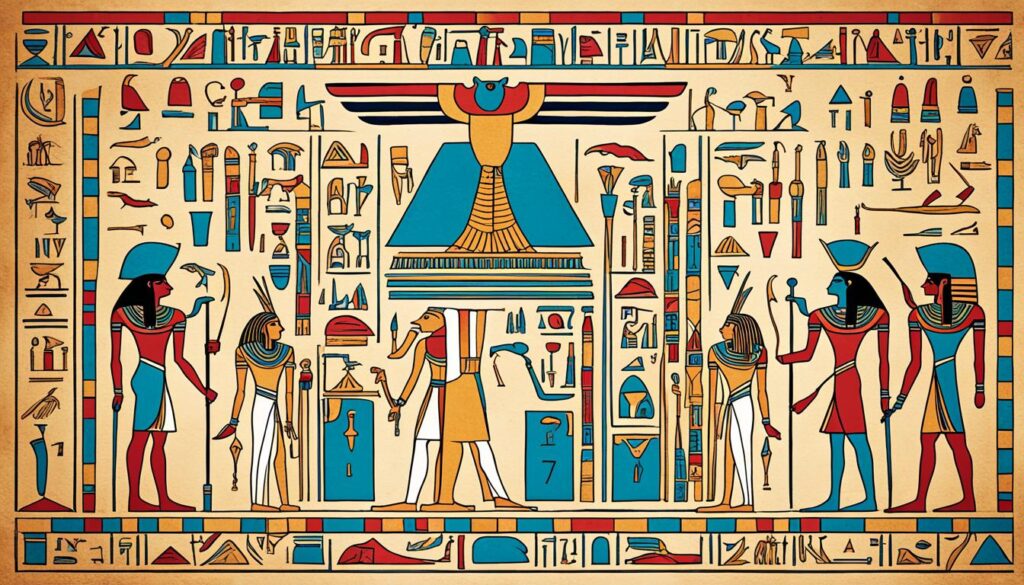
Hieroglyphic Writing and its Evolution
As the ancient Egyptian civilization advanced, its writing systems underwent a remarkable transformation. The hieroglyphic script, initially used for formal and monumental purposes, evolved to accommodate the growing needs of the society. Simplified versions known as the hieratic and demotic scripts emerged during the Ptolemaic and Roman periods, offering more efficient alternatives for day-to-day documentation and record-keeping.
While these cursive scripts gained widespread popularity, the hieroglyphic writing system continued to be used, particularly in religious, royal, and funerary contexts. The resilience of hieroglyphs is a testament to their enduring significance in Egyptian culture, as they persisted through periods of foreign rule, including the Persian, Ptolemaic, and Roman eras. Even as the understanding of hieroglyphic knowledge gradually declined, the script remained in use until the 4th century AD, when the closing of pagan temples marked the end of its active usage.
The evolution of Egyptian writing systems reflects the adaptability and versatility of the ancient Egyptians, who seamlessly integrated new forms of communication while preserving the iconic hieroglyphs as a symbol of their rich cultural heritage. This resilience and adaptability of hieroglyphic writing serve as a testament to the enduring legacy of this remarkable ancient script.
Learning to Read and Write Hieroglyphs
Mastering the art of hieroglyphic reading and writing is a captivating journey into the heart of Ancient Egyptian language and culture. By systematically studying the phonetic, logographic, and determinative signs that form the hieroglyphic script, learners can unlock the secrets of this ancient writing system and decipher the intricate inscriptions found on tomb and temple walls.
Step-by-Step Guide to Hieroglyphic Decoding
The process of decoding hieroglyphs begins with recognizing the various sign types and their corresponding sounds or meanings. Phonetic signs represent individual sounds, while logographic signs symbolize whole words or concepts. Determinative signs provide context and help differentiate between similar-looking words. With practice and perseverance, students can gradually build their understanding of the Ancient Egyptian language and its written form, starting from simple inscriptions and progressing to more complex hieroglyphic texts.
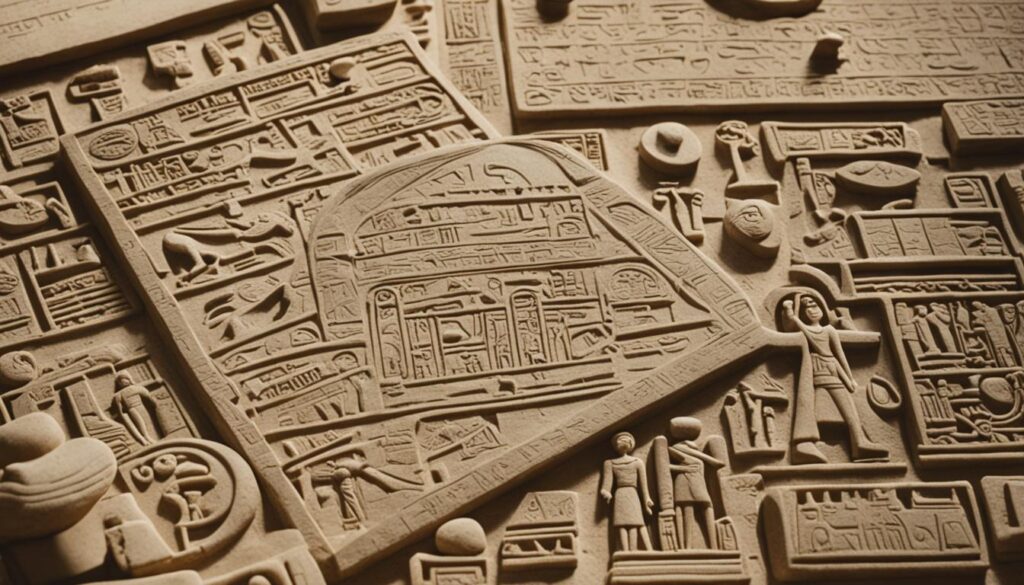
To aid in the learning process, this comprehensive guide includes a wealth of exercises and sign/word lists, allowing readers to test their decoding skills and build their confidence in hieroglyphic reading and writing. By following this step-by-step approach, aspiring Egyptologists and language enthusiasts can unlock the mysteries of one of the world’s most fascinating ancient writing systems.
Egypt: Egyptology and hieroglyphics Cairo Egypt
Cairo, the vibrant capital of Egypt, serves as a hub for the study and exploration of the country’s ancient history and culture. As a center of Egyptology, Cairo provides access to numerous archaeological sites, museums, and monuments that showcase the magnificent legacy of ancient Egyptian civilization. From the iconic Pyramids of Giza to the treasures of the Egyptian Museum, Cairo offers a wealth of opportunities to immerse oneself in the world of hieroglyphic writing and the captivating narratives it holds.
Along the banks of the majestic River Nile, the ancient Egyptian monuments and artifacts found in Cairo stand as testaments to the ingenuity and rich cultural heritage of this captivating civilization. Visitors can delve into the mysteries of hieroglyphics, the intricate script that adorned the walls of temples, tombs, and monuments, and uncover the stories they hold about the Egyptology of the region.
The vibrant city of Cairo serves as a gateway to the wonders of Egyptology, inviting scholars, tourists, and enthusiasts alike to explore the timeless allure of hieroglyphics and the ancient Egyptian world. Through its museums, archaeological sites, and ongoing research, Cairo continues to captivate and inspire those who seek to unravel the secrets of this remarkable civilization.
Significance of Hieroglyphs in Egyptian Culture
Hieroglyphic writing was deeply intertwined with the religious and cultural beliefs of ancient Egyptians. The intricate symbols and signs not only served as a means of communication but also reflected the country’s rich mythological and spiritual traditions. Hieroglyphic inscriptions found on temple walls, tombs, and sarcophagi provide valuable insights into the Egyptians’ funerary practices, beliefs about the afterlife, and the veneration of their deities and pharaohs.
Religious and Funerary Beliefs Reflected in Hieroglyphs
The hieroglyphs in ancient Egyptian culture were more than just a written language; they were a reflection of the Egyptians’ profound religious beliefs and funerary practices. The symbols and signs were believed to have sacred and symbolic meanings, often associated with the gods, the pharaohs, and the afterlife. These hieroglyphic inscriptions adorned the walls of temples, tombs, and sarcophagi, serving as a link between the mortal and the divine realms.
The Egyptians’ belief in the afterlife was a central tenet of their mythology, and this is evident in the hieroglyphic depictions of the funerary rites and the journey of the soul. The intricate funerary rituals and the mummification process were meticulously recorded using hieroglyphic writing, providing us with a unique window into the Egyptians’ spiritual and cultural beliefs.

Moreover, the hieroglyphs were used to invoke the power of the gods and goddesses, who were believed to protect the deceased and guide them through the afterlife. The names and representations of these deities were often prominently featured in the hieroglyphic inscriptions, further emphasizing the deep connection between the Egyptian mythology and their written language.
Exploring Hieroglyphic Inscriptions in Cairo
Cairo, the vibrant capital of Egypt, serves as a captivating hub for Egyptology enthusiasts. The city’s ancient monuments and archaeological sites offer a wealth of opportunities to immerse oneself in the captivating world of hieroglyphic inscriptions. From the towering Pyramids of Giza to the renowned Egyptian Museum, visitors can uncover the intricate symbols and narratives that reveal the rich cultural heritage of the ancient Egyptians.
These hieroglyphic inscriptions provide a tangible link to the lives, beliefs, and achievements of the ancient civilization. Deciphering the symbols and uncovering the stories they hold can be a truly rewarding experience for anyone interested in Egyptology. The city’s wealth of ancient Egyptian monuments, each adorned with captivating hieroglyphic writings, offers a unique opportunity to delve into the past and explore the fascinating legacy of this remarkable culture.
Cairo, as the epicenter of Egyptology, continues to captivate scholars, historians, and curious visitors alike with its incredible array of hieroglyphic inscriptions. These ancient writings, preserved on the walls of temples, tombs, and obelisks, offer a window into the sophisticated world of the ancient Egyptians, inviting us to unravel the mysteries of their language, beliefs, and traditions.
Careers and Opportunities in Egyptology
The field of Egyptology presents a wealth of career paths and opportunities for individuals fascinated by ancient Egyptian history and culture. Beyond the realm of academic research, Egyptologists can find success in diverse fields, such as museology, tourism, and heritage management.
Museology: Curating and Preserving Egyptian Artifacts
Museology, the study and practice of museum management, offers Egyptologists the chance to curate and preserve priceless Egyptian artifacts. These specialists work tirelessly to maintain the integrity and accessibility of ancient Egyptian relics, ensuring their stories are shared with the world.
Tourism: Guiding Visitors Through Iconic Sites
The tourism industry also provides ample opportunities for Egyptologists. By serving as guides at archaeological sites and interpreting hieroglyphic inscriptions, Egyptologists can play a vital role in educating and captivating visitors from around the globe.
Heritage Management: Safeguarding Cultural Legacies
Egyptologists can also contribute to the stewardship of Egypt’s rich cultural heritage, working in heritage management and consultancy roles. These professionals collaborate with government agencies, non-profit organizations, and private entities to ensure the preservation and responsible management of ancient Egyptian sites and artifacts.
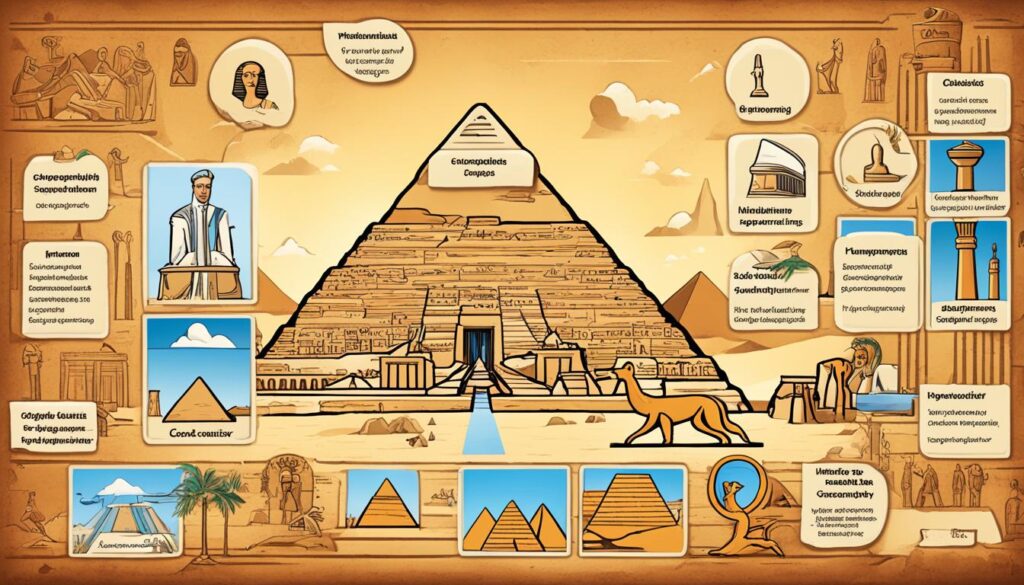
The versatility of Egyptology as a field opens up a diverse range of career paths, allowing individuals to apply their passion for ancient Egyptian history and culture in various professional settings, from museums and tourist attractions to heritage conservation and management.
Preserving Egypt’s Cultural Heritage
The preservation of ancient Egypt’s cultural heritage is a paramount concern for Egyptologists, archaeologists, and heritage professionals worldwide. Safeguarding the country’s invaluable monuments, artifacts, and hieroglyphic inscriptions is a crucial endeavor that ensures the enduring legacy of this captivating civilization.
Through collaborative efforts, innovative technologies, and dedicated research, the team of experts is working tirelessly to protect and maintain Egypt’s rich cultural treasures. From the towering pyramids to the intricate hieroglyphic writings, every aspect of this ancient legacy is being meticulously preserved for future generations to study and appreciate.
The commitment to safeguarding Egypt’s cultural heritage extends beyond just the physical preservation of artifacts. Egyptology, the study of ancient Egyptian history, language, and society, also plays a vital role in ensuring that the knowledge and understanding of this remarkable civilization continue to captivate and inspire people around the world.
By investing in research, education, and public outreach, the preservation of Egypt’s cultural heritage ensures that the enduring power of hieroglyphic writing and the allure of Egyptology will endure for centuries to come. This collective effort guarantees that the essence of ancient Egypt will remain a source of fascination and wonder for generations yet to experience the magic of this timeless legacy.
Modern Egyptology and Future Research
Egyptology, the captivating field of study focused on ancient Egypt, continues to evolve and expand, driven by the tireless efforts of scholars, researchers, and archaeologists. Powered by the rapid advancements in modern technology, the future of Egyptology holds the promise of even greater understanding and appreciation of this remarkable civilization.
New Technologies and Discoveries
From cutting-edge imaging techniques to the analysis of ancient DNA, new technologies are transforming the way scholars investigate hieroglyphic texts, archaeological sites, and cultural artifacts. These groundbreaking tools enable Egyptologists to uncover previously undiscovered insights into the lives, beliefs, and achievements of the ancient Egyptians. As these innovative approaches continue to unfold, the field of modern Egyptology is poised to reveal even more captivating secrets about this enchanting civilization.
The future of Egyptology is brimming with excitement, as researchers leverage the power of new technologies to push the boundaries of our understanding. From deciphering hieroglyphic texts with unprecedented clarity to unearthing archaeological treasures that shed light on the daily lives of ancient Egyptians, the field is constantly evolving. With each new discovery, Egyptologists are able to paint a more comprehensive and accurate portrait of this captivating culture, paving the way for a deeper appreciation of its enduring legacy.
Conclusion
The captivating world of Egyptology and hieroglyphic writing has long captivated scholars, enthusiasts, and the general public alike. From the enigmatic origins of this ancient script to its profound influence on world cultures, the legacy of ancient Egypt continues to inspire and fascinate. Through the exploration of hieroglyphic inscriptions, the preservation of cultural heritage, and the advancement of Egyptological research, we can deepen our understanding and appreciation of this remarkable civilization.
As we continue to uncover the secrets of the past, the wonders of Egyptology and the power of hieroglyphic writing will undoubtedly persist in captivating people around the globe. The ancient Egyptian civilization’s rich cultural heritage and the intriguing nature of its hieroglyphic writing system have cemented their place as enduring sources of intrigue and curiosity. By preserving and studying these remarkable artifacts, we honor the achievements of our ancestors and pave the way for future generations to explore the mysteries of Egyptology.
The journey through the captivating world of Egyptology and hieroglyphics has been a testament to the enduring impact of ancient Egyptian civilization. From the mystical origins of the hieroglyphic script to its profound influence on world cultures, this remarkable legacy continues to inspire and fascinate people worldwide. As we move forward, the wonders of Egyptology and the power of hieroglyphic writing will undoubtedly remain a captivating and integral part of our shared human heritage.
Source Links
- Egyptian hieroglyphs – https://en.wikipedia.org/wiki/Egyptian_hieroglyphs
- Egyptology – BA | – https://www.aucegypt.edu/academics/undergraduate-programs/egyptology
- AUC Press – Ancient Egyptian Hieroglyphs – https://aucpress.com/9789774249075
